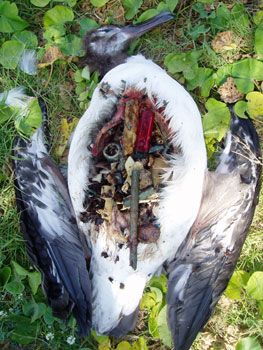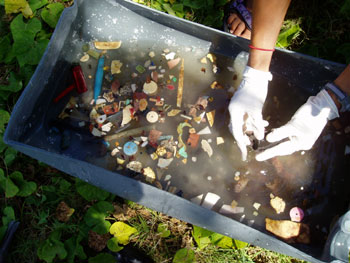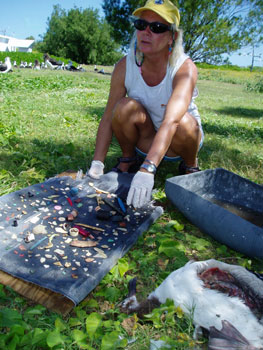|
You
are here: /main/research
expeditions/June-July
2006/ Day 15
Death of a Laysan Albatross Chick
Patricia Greene, NOAA Teacher-at-Sea
We arrived on Green Island at Kure Atoll and observed thousands of Laysan Albatross,
(Phoebastria immutabilis), chicks, and fledglings. As we walked the island we noted dead birds
among the living. To some extent this may be a natural occurrence. Only one egg is laid and both parents
nurture the chick. In the early stages the parents return often with frequent feedings. As the chick
matures and becomes older the feedings become less frequent; at this age perhaps just once a week.
The parents may travel hundreds, even thousands of miles across the Pacific Ocean far as the Aleutian
Islands to forage. Meanwhile, the chicks wait close to their hatching spot for a parent to return.

Cynthia Vanderlip selects a newly dead Laysan Albatross to perform a necropsy.
Photo: Claire Johnson/NOAA
The parent albatross has a perilous journey. On the way one or both of parents may fall victim to long
line fishing or nets, power lines, planes, sharks or other predators. If one parent is killed, the other
parent will probably not be able to provide enough food to sustain the chick; the chick will sit and wait
for the parents; eventually starve to death, or if it is old enough and ready, it may try its wings and
fledge.
In a perfect world untainted by man, our chick’s diet would consist of fish and fish eggs, squid, and
octopus. Yet in our world and the “age of plastics” the chick will likely be fed some amazing
indigestible, synthetic products.
On July 1, 2006, Cynthia Vanderlip conducted a necropsy of a chick that had expired
a few hours previous.
The “chick” had a wing spread of 5 to 6 feet and weighed approximately 5 lbs.
The contents of the bird’s
stomach amazed and shocked the teachers and scientists. The dead chick was severely
impacted and literally full of plastics. Some pieces were approximately 6 inches
long and several were sharp and jagged.
We could conclusively state this bird was killed by the plastic debris because
of the observed puncture in the lining of the proventriculus. We removed the
plastic from our bird and counted an excess of 306
pieces of plastic!

A recently expired Laysan Albatross chick with its belly full of plastic.
Photo: Claire Johnson/NOAA
Although a chick may be fed plastics, once they reach fledgling age they are
usually able to regurgitate the indigestible material and cleanse their
bodies of the plastic. However, if the pieces are too large
or in this case, large, sharp and piercing, the bird may die an agonizing death;
totally impacted and/or the lining punctured. As we walked the paths of
Green Island we observed many young dead albatross.
After viewing this incredible necropsy we contemplate how many of these young
birds may have met a similar fate to the one we necropsied. Our specimen
was chosen at random, selected only because we realized it
had died within the last few hours.
Typically, Laysan Albatrosses have a larger volume of ingested plastic than any other seabird because
their favored food, flying fish eggs, are attached to floating debris, and in our modern world most of
this debris is plastics, where it used to be wood or pumice. Floating is one of the properties of
plastics. The most recent research that we had available to us on the island regarding plastics and
albatross chicks was published in 1995. According to this research by Auman, Ludwig, Geis, and Colburn:
“ingested plastic probably does not cause a significant direct mortality in Laysan Albatross chicks,
but likely causes physiological stress as a result of satiation and mechanical blockage.
Resulting problems may include; starvation, suppressed appetite, reduced growth rate, lower fledgling
masses, obstruction of the gut, and decreased fat deposition.”
Research suggests there is an upward trend in the volume and mass of plastics found in the Laysan
Albatross chicks. In 1966, 74% of 91 chicks contained some plastic, with 8 pieces being the greatest
number found and the average mass only 1.87 grams. In the 1994/1995 study 18.1 grams and 23.8 grams
respectively. From our recent experience, we could only imagine what the numbers look like now in 2006.

Rinsing 306 pieces of plastic debris from the albatross chick. Photo: Claire Johnson/NOAA
Interestingly, much of the plastic found in the Northwestern Hawaiian Islands is of Japanese origin.
As we walked the beach we observed many plastic articles with Japanese writing on them. In the boli
from chicks we observed Japanese cigarette lighters and in our specimen there was a piece of plastic
with Japanese writing on it. Some of the debris may be from Japanese fishing boats or perhaps from
the warm Kuroshiro current that flows from Japan.
Another concern
is when the albatross eats burned or melted plastic parts. These are especially toxic because of release
of organochlorines; polychlorinated biphenyls (PCB’s) and phospholipid foams, which can be absorbed and
harmful to both the adult birds and their chicks. Many pieces of burnt plastics were observed on the
island and in the chick Cynthia conducted a necropsy on.

The author, Patty Greene, sorts through the 306 pieces of plastic debris
found
in a Laysan Albatross chick on Green Island. Photo: Claire Johnson/NOAA
In a few days, our bird will be gone; devoured by the decomposers and scavengers. At night the ghost
crabs will come out of their burrows and feast on him; beetles and fly larvae will clean up the remains.
Soon the bird will be reduced to just a pile of feathers but the plastics we found will remain for years.
 Talk About It! Talk About It!
NWHI Pictures
Asked by Jennifer from San Diego Natural History Museum on May 19, 2008.
Hello,
We are interested in using one or several of photographer Claire Johnson's albatross photos in our upcoming exhibit: "Water: A California Story". How can we contact her?
Thank you for your help,
Jennifer
Answered by Paulo from NOAA on May 21, 2008.
Hello, Jennifer. It's good to know about your project, and of your interest in Claire's pictures. I've forward your request to her, and we'll work to get you the picture that you need. Use of NOAA NWHI photos for Education
Asked by Tina from Oregon Coast Aquarium on Sep 15, 2008.
Hi there - We are working on an interpretive sign that talks about the harmful effects of marine debris on marine life. We would like to use one of the photos taken by Cynthia Vanderlip (the albatross with a stomach full of plastics) as one of the photos on our sign. How do we get permission to use it and is there a fee?
Thank you.
Tina
Answered by Paulo on Sep 17, 2008.
Hi Tina! Thank you for your interest in the photo, albatrosses and plastics. For the most part, the photos taken during expeditions to the NWHI are public domain and can be used for educational purposes by anyone. There's no fee to use the photo, but we ask that both the photographer and NOAA are acknowledged. The particular photo that you mentioned was taken by Claire. I'll get you in touch with her so perhaps you can get a higher definition photo for you to use.
All the best with your marine debris project!
Paulo Access to Albatross Pictures
Asked by Jon from Royal Australian Navy on Nov 9, 2008.
I am producing a training video for navy sailors to ensure that they understand the environmental consequenses of certain activities at sea e.g. ditching garbage. The video opens with the appalling story of albatross chicks being fed items of plastic by their parents and subsequently dying a horrible death. I would very much like to use all four photographs, but regret that I need high resolution images for the video. I am more than willing to pay for this privilege.
Best regards,
Jon Sarvis.
Answered by Paulo from NOAA on Nov 16, 2008.
Dear Jon,
It is great to hear about your effort. I will soon put you in touch with the photographer so you can have access to these pictures.
Best luck in producing your training video,
Paulo Maurin Smart educated beauty on an island.
Asked by T.J. from Associated Press on Mar 11, 2009.
Wow hats off to Cynthia Vanderlip for her devotion to her research on Kure and wow is she married as she is way hot with her dreads!!!!!!!!!!a smart educated beauty on a island how good is that! Keep up the great work Cynthia
TJ
Answered by Andy from NOAA on Mar 11, 2009.
Aloha T.J.
Thanks for your comments and support. I forwarded your message on to Cynthia.
Best,
Andy Use of photo for educational purposes
Asked by Andy from The Society of Wilderness on Jul 16, 2012.
The Society of Wilderness
204 Zhao'an Street
Taipei, Taiwan 10073
Dear Hawaiianatolls.org,
We are one of NGOs in Taiwan, holding the activity of International Coastal Cleanup (ICC) in Taiwan every year. In this year's ICC, we will focus on the albatross, which suffered from plastic garbage for a long time. We are going to use the albatross as an example to emphasize the importance of coastal cleanup. To design the teaching material such as PowerPoint presentations or Slideshows for training volunteers, we need to collect some ecological pictures of albatross. We wonder if we can use the following image with a copyright statement on purpose of educational usage.
Link of the image : http://www.hawaiianatolls.org/images/June_06/albatross_open_belly.jpg
(A recently expired Laysan Albatross chick with its belly full of plastic.
Photo: Claire Johnson/NOAA)
)
The website that contents the image : http://www.hawaiianatolls.org/research/June2006/albatross_death.php
Thank you so much for reading this email. We would like to know if you agree with the image usage and we are looking forward to receiving the reply from you.
Sincerely,
Andy Chen
Answered by Dan Suthers, University of Hawaii on Jul 24, 2012.
Dear Andy,
You may use this picture provided you include the credit as indicated in your email or below.
Photo: Claire Johnson/NOAA
All of our materials on this site are intended for noncommercial educational use free of charge.
Good luck with your project! |